A summary of synthetic diamond processes and identification techniques
Diamonds, the ultimate mineral and rightfully so, the geological process that creates this mineral unlike any other gemstone due to the ability to withstand high temperatures and pressure, and intense mining process. Diamonds like most valuable gemstones, have a synthetic counterpart, yet the identification can provide a huge challenge to end consumers and within the trade. Small, melee-sized synthetic diamonds can easily be mixed into parcels, sold to diamond dealers, jewelry stores, and manufacturers who are unaware that they are selling synthetic diamonds. With enough experience it is possible for a gemologist to make a proper identification using classical techniques alone, yet natural looking inclusions, or the lack of inclusions can provide a huge challenge with most synthetic diamonds therefore understanding when to send a diamond to a gem lab for advanced testing is essential.
This project will first discuss the heterogeneous synthetic processes of diamond. To attain a better understanding of identification it is important to have background knowledge of how these stones are grown. First the history and manufacturing process of synthetic diamond will be briefly reviewed, then identification using classical gemological techniques, along with advanced analytical equipment. Specifically, internal features and chemical composition of synthetic colorless and colored diamond will be detailed, (table top tools such as SWUV and advanced equipment. I will outline colorless and colored diamond classic testing and advanced testing in both HPHT and CVD methods.
Brief overview on diamond types before the paper continues:
- Synthetic diamonds are usually type Ib,IIa, and IIb, these types are very rare in nature.
- Synthetic type Ib diamonds are very common in comparison to natural Ib which are rare (Walker, 1979)
- Type Ia diamonds cannot be synthetically grown, and can be confirmed using advanced spectroscopy. (C.Breeding,J.Shigley, SUMMER 2009)

High Pressure High Temperature Synthetic Diamonds (HPHT)
This was the first commercial method for the synthesis of synthetic diamonds first carried out in the 1950s. HPHT diamonds can be creating using a cubic,toriod or bars apparatus. Each methodology produces similar results. A few things are needed to manufacture diamonds with the HPHT method. A reaction cell (or container) (Robert Linares Integrated Diamond Technologies, LLC, 2013) is filled with a carbon source. Any form of carbon is sufficient, but the preferred source of carbon is diamond powder because the atoms are compacted closer together, the carbon source is then placed on top of a seed crystal.It is possible for nucleation to occur without a seed crystal but the seed prevents the production of smaller micro crystals. Either a synthetic or natural diamond can be used as a seed crystal. (Gemmological Association of Great Britian, 2014)
A molten metal catalyst is used to melt materials at a lower temperature that might otherwise have a higher melting point, this is a mixture of cobalt, iron or nickel. The lower melting points would also require less pressure during the production making the synthetic diamonds much easier to grow(and is used to enable crystal growth). Different materials, resulting in different trace element composition, and identifying features will be present depending on the growth procedure and metallic flux used, yet a reaction cell will always be needed. (Robert Linares Integrated Diamond Technologies, LLC, 2013) (W, et al., n.d.)
The capsule is then heated under pressure at approximately 1300-1600 C and 5-6gpal. The HPHT method takes advantage of the temperature gradient method, where the carbon source is located in a hotter region than the seed crystal. The carbon source migrates towards the cooler parts of the capsule, dissolving and becoming super saturated in the solvent inhibiting crystal growth.
During growth process the diamonds can be doped with elements intentional or otherwise, which could aid us in identification. The bars,belt and cubic press are ways diamonds can be produced using HPHT method; I will summarize on the differences between these processes because some of the advanced testing results can be specific to the production method.
HPHT synthetic diamond crystals can have a variety of distinctive shapes, resulting from the temperature, pressure and orientation of the seed crystal during synthesis.
Combined forms such as cubes and octahedrons are common forming a truncated cube or octahedron. (Gemmological Association of Great Britian, 2014) (Eaton-Magaña, Shigley, & Breeding, Observations on HPHT-Grown Synthetic Diamonds: A Review, Fall 2017)

Chemical Vapour Deposition (CVD) or Low Low Pressure High Temperature (LPHT):
Manufactures originally supported the idea of CVD diamonds in order to mass produce synthetic diamonds in a more cost-effective way; This process requires far less pressure and slightly less temperature to produce synthetic diamonds compared to the HPHT process; but less desirable materials were produced and there was no real consistency. Most of the CVD colorless diamonds on the market today are assumed to be HPHT treated, but with advances in technology this is not always the case as more pure crystals can be produced. The biggest issue with HPHT treatment of CVD diamonds is that key features for identification would be masked in these synthetic diamonds (Robert Linares Integrated Diamond Technologies, LLC, 2013).
CVD Diamonds are produced by heating a carbon containing gas (such as methane) with hydrogen in a vacuum at low pressure and elevated temperature. A microwave beam is used to break down the gas so carbon falls down to a seed plate, the longer the crystal is left in the vacuum the larger the crystal is able to grow; either a natural or synthetic seed plate can be used
The hydrogen inside the growth chamber changes to an atomic hydrogen which facilitates crystal growth in a more stable environment. Methane and oxygen more consistent diamond growth. (Gemmological Association of Great Britian, 2014)) Colorless diamonds are able to be produced due to the fact there is only carbon and hydrogen in the mixture yet blue and yellow diamonds can be produced by adding nitrogen or boron.
CVD crystals can look like a cube be flat and tabular; the edges are rough looking due to the undissolved graphite during the growth process.
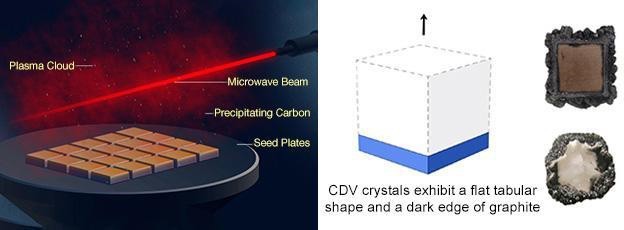

Without delving deeper, this fundamentally explains the nucleation process of synthetic diamond and their distinguishing features.
Observation:
The use of classical instruments while working in the field can be useful and practical. A microscope, fluorescent light, and a polariscope can go a long way for a trained gemmologist.
The first thing we want to do is observe the diamond with a 10x lens, when inclusions are present in CVD diamonds it can still be very difficult to understand if we are looking at non diamond inclusions. If any dark carbon inclusions or colorless pinpoints are present in a CVD diamond it would be restricted to one plane (parallel to the seed) (S.Eaton-Magaña, J.Shigley Fall 2016). This can take a lot of experience to discover and due to the various diamond formation environments, I would not consider this to be conclusive (Earon-Magana & Shigley, Fall 2016) (Martineau, et al., Spring 2004)the other downfall of magnification is most CVD diamonds are being produced in the VVS2-VS2 clarity range and would therefore need to conduct additional testing to determine suspicion for synthetic.
HPHT synthetic diamonds can have clarities from IF-I3 along with any color along the D-Z range. Dark, opaque, and highly reflective metallic inclusions are common in HPHT synthetic diamond. These inclusions originate from the flux used to grow these diamonds. These inclusions can sometimes be rod shaped, but the presence should only arouse suspicion that what is being looked at is synthetic. These diamonds can actually be attracted by a rare earth element magnet (S.Eaton-Magaña, J.Shigley Fall 2016). Surface reaching feathers may also be present yet can also occur in natural diamond. The majority of HPHT synthetic diamonds are type Ib, natural type Ib diamonds would usually have natural mineral inclusions therefore general observation can be diagnostic. (C.Breeding,J.Shigley, SUMMER 2009)

Colored CVD diamonds have a more even color distribution while HPHT synthetic colored diamonds may display distinctive color zoning. The zoning generally looks square or cross shaped.
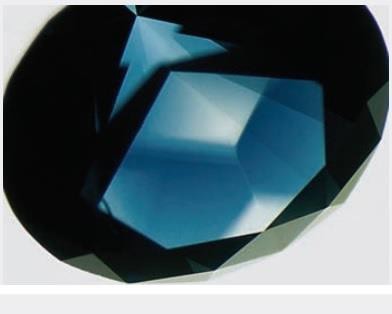
After observing the diamond under magnification, the next test should be UV fluorescence, while working in the field this could potentially be diagnostic. This is also a cost effective, and time saving test when observing multiple diamonds that may be set in a piece of jewelry.
Blue and yellow fluorescent colors are common in natural diamonds, and other colors, while possible should raise suspicion. It is important to view the stone in question under both SW and LW UV light; Not only are the colors important but comparing the intensities can be diagnostic. If a colorless to near colorless diamond reacts more strongly under SW UV than LW UV we have a strong indication that diamond in question is HPHT synthetic (Earon-Magana & Shigley, Fall 2016). Yet if we get an inert reaction, an equal intensity or if the intensity is stronger in LW we must conduct additional tests as the stone could be natural or synthetic; It is very possible to mistake a very faint reaction under SW UV for being inert so caution is required when viewing these results. Prolonged phosphorescence after being exposed to SW UV is common in HPHT synthetic diamond, so be sure to observe the diamond after it is exposed to UV light. This is more true for older HPHT synthetics.
HPHT SYNTHETIC: In a comprehensive summary of diamonds examined at GIA from 2004 to 2017, Only 2% of HPHT synthetic colorless diamonds submitted to the lab displayed a reaction to LWUV, while 88% of colorless HPHT synthetic diamonds had a reaction under SWUV.
35% of colorless natural diamonds display a reaction under LWUV and 99% of the time when testing a fluorescent colorless natural diamond under LWUV the reaction was blue.
The most interesting reaction in their study must be that across all colors 78% displayed no reaction under LWUV and 38% displayed no reaction under SWUV This study was published in gems and gemology (S.Eaton-Magaña, J.Shigley Fall 2016).
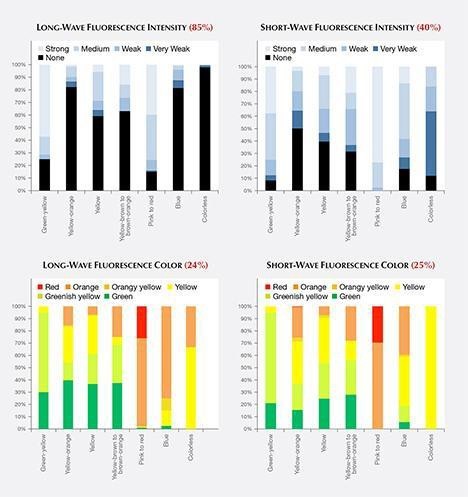
CVD:
As growth technology improves, our testing gets more limited. All of the CVD samples tested by GIA since 2013 displayed no reaction to LWUV, in older material it was reported to show a green fluorescent color under LWUV. (S.Eaton-Magaña, J.Shigley Fall 2016)
CVD pink diamonds are a result of post growth treatment and generally display a strong orange to red fluorescence. The tricky thing when trying to separate a natural from synthetic pink diamond based on fluorescent reaction is that an inert reaction is very possible in both CVD post treated pink diamond and natural diamond (S.Eaton-Magaña, J.Shigley Fall 2016). A very small percentage of natural diamonds can also display an orange reaction, further testing is always needed, and fluorescence alone should not be used to make an identification. Another thing to consider is that just because a diamond is natural does not mean the color is natural therefore it is best to send suspicious specimens to a lab for advanced testing (P. Martineau, S. Lawson, A. Taylor, S. Quinn, D. Evans, M. Crowder Spring 2004).
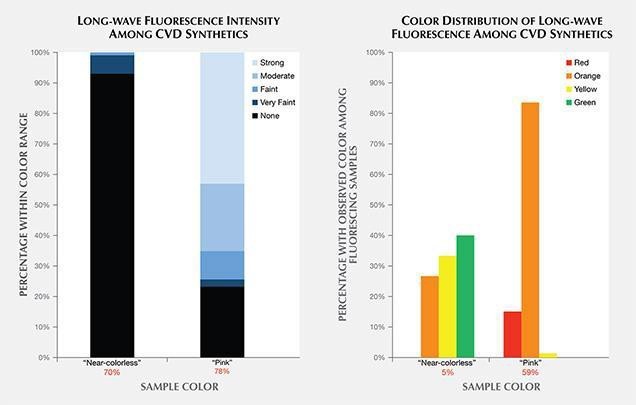
Cross polarized filters fitted onto a microscope can help a gemologist determine the level of “strain” within the diamond. These strains are caused by disruptions in the crystal lattice. Strain patterns can also help determine diamond type which is essential, especially if you confirm that you have a type II diamond.Understanding these results takes a lot of experience. (H. Kitawaki, M.Hisanaga, M.Yamamoto and K. Emori, 2015)
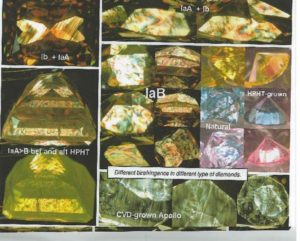
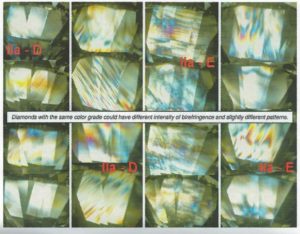
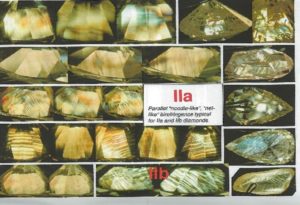
Testing Instruments:
Screening instruments such as the DiamondSure from the DTC can be used to aid in the identification of synthetic diamonds by rapidly screening the diamond type. This instrument passes most type IA diamonds as natural by detecting the 415 nm line seen in most natural diamonds. And referring a stone for further testing if this is not detected (P. Martineau, S. Lawson, A. Taylor, S. Quinn, D. Evans, M. Crowder, Spring 2004) (Walker, 1979). Approximately 2% of natural diamonds and most synthetic diamonds are type IIA or IaB. Some literature suggests that a 415nm absorption cannot be seen in synthetic diamonds, but this is only true for as grown synthetics. The 415nm line has been observed in CVD diamonds where a nitrogen getter is added followed by HPHT treatment. The HPHT treatment causes the nitrogen within the structure to aggregate, but the Diamond Sure will still give a “REFER” result when tested (P. Martineau, S. Lawson, A. Taylor, S. Quinn, D. Evans, M. Crowder, Spring 2004) (H. Kitawaki, M.Hisanaga, M.Yamamoto and K. Emori, 2015) (Welbourn, Cooper, & Spear, DEBEERS NATURAL VERSUS SYNTHEHTIC DIAMOND VERIFICATION INSTRUMENTS, Fall 1996). It is important not
to only rely on this instrument, this test needs to be used in conjunction with other testing for a proper identification. Some other screening devices which take advantage of the transmission (type II diamonds) / absorption (type I diamonds) of SW UV light is the SSEF diamond illuminator and the HRD D-Screen.
After conducting these tests it is still very possible that we cannot identify our diamond as natural or synthetic. It is important to understand your limitations, and your skill set if you do not have experience with these tests and send a diamond (or parcel of diamonds) to a gem lab for advanced testing. In the next section I will discuss tests and results for common instruments you may see in a gem lab.
Diamond View:
The diamond view is an observational instrument which allows the user to view fluorescent reactions real time. Although some natural CVD, and even HPHT diamonds may emit no reaction to longwave and shortwave UV light (Eaton-Magaña, Shigley, & Breeding, Observations on HPHT-Grown Synthetic Diamonds: A Review, Fall 2017); every diamond natural, CVD, or HPHT will display some sort of reaction to the high energy of the UV source in the diamond view. This is at a shorter wavelength is at 225 nm (Eaton-Magaña & Breeding, AN INTRODUCTION TO PHOTOLUMINESCENCE SPECTROSCOPY FOR DIAMOND AND ITS APPLICATIONS IN GEMOLOGY, Spring 2016)(P. Martineau, S. Lawson, A. Taylor, S.
Quinn, D. Evans, M. Crowder, Spring 2004). Not only is fluorescent color looked at with the diamond view but growth patterns caused by differential concentrations of impurities between growth sectors can be seen as well(S.Eaton-Magaña, J.Shigley Fall 2016) (S. Eaton-Magaña J. Shigley, Fall 2017).
HPHT Synthetic Diamonds:
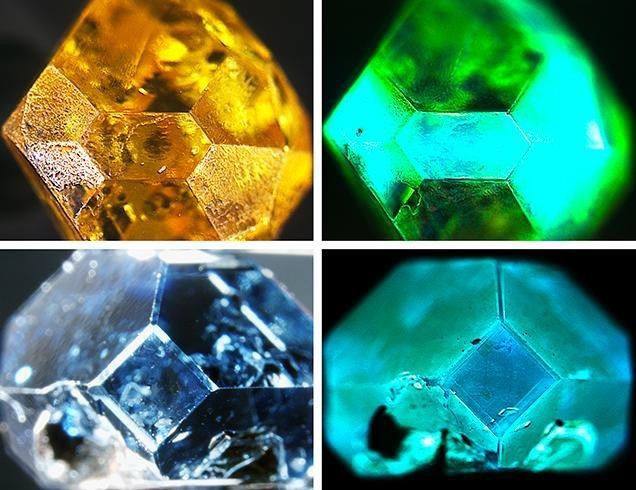
It is much more difficult to see this difference in fluorescent color when observing colorless to near colorless materials.
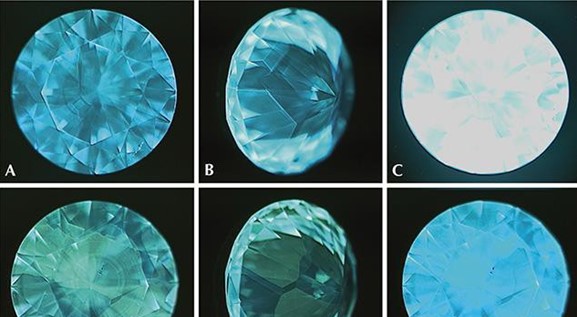
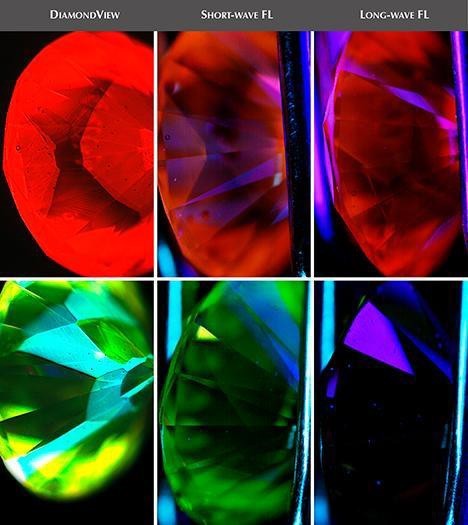
The top stone is a HPHT synthetic pink diamond while the bottom is a fancy vivid orange. The top images shows characteristic features of HPHT synthetic diamond under the diamond view and SW UV while the bottom sample has no diagnostic growth pattern under SW UV. (The reaction under SWUV is more intense under LW but this example is to be used for growth pattern identification. (S.Eaton-Magaña, J.Shigley Fall 2016) (S. Eaton-Magaña J. Shigley, Fall 2017) (Martineau, et al., Spring 2004)

CVD Synthetic Diamond Reactions:
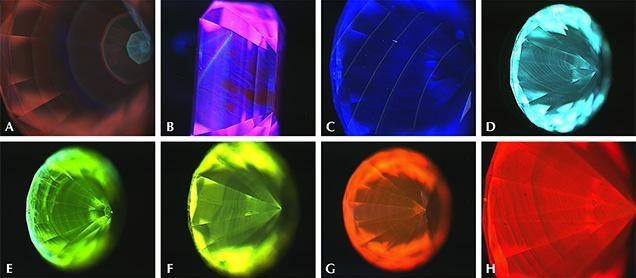
CVD diamonds show more of a striated pattern. Figures B to D show typical patterns and fluorescent colors in near colorless cvd diamond while figures E to H are typical reaction for synthetic pink diamonds. The thin concentric striations are best seen through the pavilion (S.Eaton-Magaña, J.Shigley Fall 2016) (P. Martineau, S. Lawson, A. Taylor, S. Quinn, D. Evans, M. Crowder, Spring 2004).As mentioned earlier these striations are from the layered growth structure of CVD diamonds.
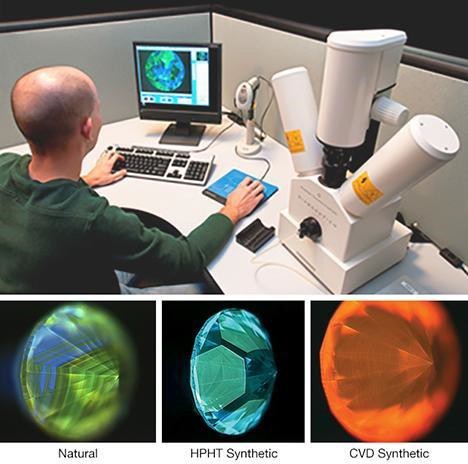
Experience is vital, some high purity CVD diamonds could be mistaken for natural especially when there is less intense luminescence, these diamonds are not commercially produced but as technology advances it would be a good idea to confirm with an additional piece of advanced equipment. (P. Martineau, S. Lawson, A. Taylor, S. Quinn, D. Evans, M. Crowder, Spring 2004) (K. Corte, A.Jef Van Royen,M.Blanchaert,J. Barjon, B. Willems, Fall 2006).

FTIR spectroscopy can measure the absorption of a material in the infrared part of the electromagnetic spectrum, which can aid in the identification of natural or synthetic diamond; the results are plotted as a function of energy. The presence or the lack of peaks will give indication of diamond type and origin.


- If a diamond can be identified as type Ia from its aggregated nitrogen impurities we can be sure it is natural
- Type IIa diamonds can readily be identifiable from its lack of impurities
- Type IIb diamonds can be identified from its boron impurities

Blue CVD diamonds can be identified from its lack of boron therefore being classified as type IIa, unlike their HPHT and natural counterparts. (F, et al., n.d.)
In an article by GRS, the 1332cm peak is said to be a main feature related to a N+ Centre.
In another study done by GIA 40 BARS method samples were tested in with a FTIR spectra scope, a peak at 1332cm was observed in 37 out of the 40 samples; this is suggested to be a vacancy created from the metal catalyst during the growth process. This line is rarely seen in natural diamonds.

If we compare CVD near-colorless, orange to pink and dark brown we can see the same 1332cm peak; although in the near colorless range it is much weaker (Wang, Hall, Moe, Tower, & Moses, 2007) All of the samples tested in figure 24 are type IIA, in this same study an E- VVS2 CVD synthetic had no detectable absorption in the near infrared (Wang, Hall, Moe, Tower, & Moses, 2007). I believe the 1332 cm should not be used as a diagnostic feature alone for synthetic diamonds, and additional testing should still be conducted.

Photoluminescence Spectroscopy (PL spectroscopy):
PL is a tool used to look at the slight difference within the crystal lattice to determine if a diamond is natural, synthetic or treated. Virtually all type II diamonds should undergo PL evaluation to make a proper identification.
During CVD growth, or HPHT doped with Si it is very likely that a silicon vacancy center is created (Si-V) the presence of silicon from the growth apparatus fills in vacancies within the diamond structure and the silicon is separated by carbon atoms. ( (Mu¨ller, Hepp, & Pingault, 2014))
This sort of vacancy is very rare in natural diamond, yet if it does occur it can usually be confirmed natural from further testing (natural mineral inclusion would most probably be present) (Wang C. B., 2008) (Wang B. “., Winter 2016).
Figure 26 shows a Si-V with a peak or a zero phonon line (ZPL) at 737nm typical in CVD diamond (Martineau, et al., Spring 2004) (Elke, et al., 2013) (P. Lai, W. Wang Winter 2016).
Compared to samples A,B,C in figure 25 which are natural type IIa diamonds and sample D which is a natural type Ia, where no peak Is seen.



This quote further supports the statements that a peak at approx 737nm and approx 1332cm (in this case 1333cm) together are indicative of synthetic diamonds (Martineau, et al., Spring 2004)Other tools such as cathodoluminescence, UV-Vis spectrometer, and Raman spectroscopy are generally found in a well-equipped lab. The information I provided from the FTIR and PL spectrum should give an idea on just how complicated testing for synthetic diamonds can be. Depending on what is being tested Several other peaks / absorption bands are looked at to provide valuable information (Eaton-Magaña & Breeding, AN INTRODUCTION TO PHOTOLUMINESCENCE SPECTROSCOPY FOR DIAMOND AND ITS APPLICATIONS IN GEMOLOGY, Spring 2016).
Conclusion
It can be a challenging task to identify synthetic diamonds, even with access to advanced analytical equipment in some cases. Internal features, and UV fluorescence will be the best option while working in the field; The cross polarized filter technique can be just as valuable when it comes to identifying HPHT synthetic diamonds, yet much experience is needed. The DTC DiamondSure is an affordable tool that can give “PASS” and “REFER” results, when getting a “PASS” result no further testing is needed.
References
Breeding, C. M., & Shigley, J. E. (SUMMER 2009). THE “TYPE” CLASSIFICATION SYSTEM OF DIAMONDS
AND ITS IMPORTANCE IN GEMOLOGY. GEMS AND GEMOLOGY, 45(3), 97-103. Retrieved from
https://www.gia.edu/doc/The-%E2%80%9CType%E2%80%9D-Classification-System-of- Diamonds.pdf
De Corte, K., Anthonis, A., Van Royen, J., Blanchaert, M., Baron, J., & Willems, B. (Fall 2006). Overview of Dislocation Networks in type IIa diamonds. Gems and Gemology, XLII, 122. Retrieved from https://www.gia.edu/doc/FA06.pdf
Earon-Magana, S., & Shigley, J. E. (Fall 2016). Observations on CVD-Grown Synthetic Diamonds: A Review. Gems and Gemology, 52(No. 3). Retrieved from https://www.gia.edu/gems- gemology/fall-2016-observations-cvd-grown-synthetic-diamonds-review
Eaton-Magaña, S., & Breeding, C. M. (Spring 2016). AN INTRODUCTION TO PHOTOLUMINESCENCE SPECTROSCOPY FOR DIAMOND AND ITS APPLICATIONS IN GEMOLOGY. GEMS AND GEMOLOGY,
2-16. Retrieved from https://www.researchgate.net/profile/Sally_Eaton- Magana/publication/302982754_An_Introduction_to_Photoluminescence_Spectroscopy_for_Di amond_and_Its_Applications_in_Gemology/links/574d9b4308ae8bc5d15bb477/An- Introduction-to-Photoluminescence-Spectroscopy-f
Eaton-Magaña, S., Shigley, J. E., & Breeding, C. M. (Fall 2017). Observations on HPHT-Grown Synthetic Diamonds: A Review. Gems and Gemology, 53(3). Retrieved from https://www.gia.edu/gems- gemology/fall-2017-observations-hpht-grown-synthetic-diamonds
Elke, N., Hepp, C., Stefan, G., Hauschild, M., Sternschulte, H., Steinmuller-Nethl, D., . . . Becher, C. (2013, April). Low-temperature investigations of single silicon vacancy colour centres in diamond. New Journal of Physics, 15. Retrieved from http://iopscience.iop.org/article/10.1088/1367- 2630/15/4/043005#nj449225s4
F, H., Bieri, W., Alessandri, M., Gunther, D., Frick, D., Cleveland, E., & Zaitsev. (n.d.). New Generation of Synthehtic Diamonds Reaches The Markey Part A: Identification of CVD- grown blue diamonds. Retrieved from www.gemresearch.ch: http://gemresearch.ch/wp/wp- content/uploads/2015/10/Journal-14.pdf
Gemmological Association of Great Britian. (2009). Diploma in Gemmology. London.
Kitawaki, H., Hisanaga, M., Yamamoto, M., & Emori, K. (2015). Type Ib Yellow to Brownish Yellow CVD Synthetic Diamonds Seen at CGL. GEMS AND GEMOLOGY, 34(7), 594-602. Retrieved from https://gem-a.com/images/Documents/JoG/2015/The-Journal-of-Gemmology-347-2015–LR- FINAL.pdf
Martineau, P., Lawson, S., Taylor, A., Quinn, S., Evans, D., & Crowder, M. (Spring 2004). IDENTIFICATION OF SYNTHETIC USING CHEMICAL VAPOR DEPOSITION (CVD). Gems and Gemology, 4(No 1), 3-23.
Retrieved from https://www.gia.edu/doc/Identification-of-Synthetic-Diamond-Grown-Using- Chemical-Vapor-Deposition-CVD.pdf
Mu¨ller, T., Hepp, C., & Pingault, B. (2014, Februrary). Optical signatures of silicon-vacancy spins in diamond. Retrieved from https://www.nature.com/articles/ncomms4328.pdf?proof=true: https://www.nature.com/articles/ncomms4328.pdf?proof=true
Robert Linares Integrated Diamond Technologies, LLC. (2013, April 30th). CVD-Grown Synthetic Diamonds, Part 1: History. Retrieved from www.gia.edu: https://www.gia.edu/news-research- CVD-grown-part1
Simic, D., & Branko, D. (n.d.). Idenifying Diamond Types and Synthetic Dimonds with CPF Second edition.
Ulrika F.S. D’Haenens-Johansson, K. S. (Spring 2014). Near-Colorless HPHT Synthetic Diamonds from AOTC Group. Gems and Gemmology, 50(No.1), V. Retrieved from https://www.gia.edu/gems- gemology/spring-2014-ulrika-hpht-synthetic-diamonds#item-1
Walker, J. (1979). Optical absorption and luminescence in diamond. Prog. Phys, 42, 1610. Retrieved from https://accreditedgemologists.org/lightingtaskforce/OpticalAbsorptionand.pdf
Wang, B. “. (Winter 2016). CVD Synthetic Diamond Over 5 Carats Identified by GIA. Gems and Gemology, 52(4). Retrieved from https://www.gia.edu/gems-gemology/winter-2016-labnotes-cvd- synthetic-diamond-over-5-carats-identified
Wang, C. B. (2008). Occurrence of the Si–V defect center in natural colorless gem diamonds. Diamonds and related materials, 1335-1344. Retrieved from https://www.researchgate.net/publication/229257458_Occurrence_of_the_Si- V_defect_center_in_natural_colorless_gem_diamonds
Wang, W., Hall, M. S., Moe, K. S., Tower, J., & Moses, T. M. (2007). LATEST-GENERATION CVD-GROWN SYNTHETIC DIAMONDS FROM APOLLO DIAMOND INC. GEMS AND GEMOLOGY, XLIII, 294-307.
Retrieved from https://www.gia.edu/doc/WN07.pdf
Welbourn, C. (Fall 2006). Identification of Synthetic Diamonds:Present Status and Future Developments.
Gems and Gemology, XLII, 34-35. Retrieved from https://www.gia.edu/doc/FA06.pdf
Welbourn, C., Cooper, M., & Spear, P. (Fall 1996). DEBEERS NATURAL VERSUS SYNTHEHTIC DIAMOND
VERIFICATION INSTRUMENTS. Gems and Gemology, 156-167. Retrieved from https://www.gia.edu/doc/De-Beers-Natural-versus-Synthetic-Diamond-Verification-
Instruments.pdf
www.gia.edu. (n.d.). Retrieved from https://www.gia.edu/gia-news-research-improved-quality- identification-challenges



